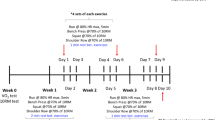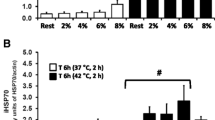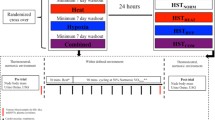Abstract
We investigated the effect of exercise in the heat on both intracellular and extracellular Hsp72 in athletes with a prior history of exertional heat illness (EHI). Two groups of runners, one consisting of athletes who had a previous history of EHI, and a control group (CON) of similar age (29.7 ± 1.2 and 29.1 ± 2 years CON vs. EHI) and fitness [maximal oxygen consumption \((\dot V{{\text{O}}_2}\hbox{max} )\) 65.7 ± 2 and 64.5 ± 3 ml kg−1 min−1 CON vs. EHI] were recruited. Seven subjects in each group ran on a treadmill for 1 h at 72 % \(\dot V{{\text{O}}_2}\hbox{max}\) in warm conditions (30 °C, 40 % RH) reaching rectal temperatures of ~39.3 (CON) and ~39.2 °C (EHI). Blood was collected every 10 min during exercise and plasma was analysed for extracellular Hsp72. Intracellular Hsp72 levels were measured in both monocytes and lymphocytes before and immediately after the 60-min run, and then after 1 h recovery at an ambient temperature of 24 °C. Plasma Hsp72 increased from 1.18 ± 0.14 and 0.86 ± 0.08 ng/ml (CON vs. EHI) at rest to 4.56 ± 0.63 and 4.04 ± 0.45 ng/ml (CON vs. EHI, respectively) at the end of exercise (p < 0.001), with no difference between groups. Lymphocyte Hsp72 was lower in the EHI group at 60 min of exercise (p < 0.05), while monocyte Hsp72 was not different between groups. The results of the present study suggest that the plasma Hsp72 response to exercise in athletes with a prior history of EHI remained similar to that of the CON group, while the lymphocyte Hsp72 response was reduced.




Similar content being viewed by others
References
Asea A, Rehli M, Kabingu E, Boch JA, Bare O, Auron PE, Stevenson MA, Calderwood SK (2002) Novel signal transduction pathway utilized by extracellular Hsp70. J Biol Chem 277:15028–15034
Bautmans I, Njemini R, Vasseur S, Chabert H, Moens L, Demanet C, Mets T (2005) Biochemical changes in response to intensive resistance exercise training in the elderly. Gerontology 51:253–265
Bedford T (1936) The warmth factor in comfort at work: a physiological study of heating and ventilation. In: McIntyre DA (ed) Indoor climate Industrial Health Research Board Report No 76, vol 76. HMSO, London
Borg G (1982) Psychophysical bases of perceived exertion. Med Sci Sports Exerc 14:377–381
Boshoff T, Lombard F, Eiselen R, Bornman JJ, Bachelet M, Polla BS, Bornman L (2000) Differential basal synthesis of Hsp70/Hsc70 contributes to interindividual variation in Hsp70/Hsc70 inducibility. Cell Mol Life Sci 2000:1317–1325
Bouchama A, Knochel JP (2002) Medical progress: heat stroke. N Engl J Med 346:1978–1988
de Maio A (2011) Extracellular heat shock proteins, cellular export vesicles, and the stress observation system: a form of communication during injury, infection, and cell damage. Cell Stress Chaperones 16:235–249
Demidov ON, Tyrenko VV, Svistov AS, Komarova YY, Karpishenko AI, Margulis BA, Shevchenko YL (1999) Heat shock proteins in cardiosurgery patients. Eur J Cardiothorac Surg 16:444–449
Dill DB, Costill DL (1974) Calculation of percentage changes in volumes of blood, plasma, and red cells in dehydration. J Appl Physiol 37:247–248
Dybdahl B, Wahba A, Lien E, Trude H, Waage A, Qureshi N, Sellevold O, Espevik T, Sundan A (2002) Inflammatory response after open heart surgery: release of heat shock protein 70 and signalling through toll-like receptor 4. Circulation 105:685–690
Febbraio MA, Ott P, Nielsen HB, Steensberg A, Keller C, Krustrup P, Secher NH, Pedersen BK (2002) Exercise induces hepatosplanchnic release of heat shock protein 72 in humans. J Physiol 544(3):957–962
Fehrenbach E, Niess AM, Veith R, Dickhuth H-H, Nothoff H (2001) Changes of Hsp72 expression in leukocytes are associated with adaptation to exercise under conditions of high environmental temperature. J Leukoc Biol 69:747–754
Heck TG, Scholer CM, Bittencourt PIH (2011) Hsp70 expression: does it a novel fatigue signalling factor from immune system to brain? Cell Biochem Funct 29:215–226
Horn PL, Pyne DB, Hopkins WG, Barnes CJ (2010) Lower white blood cell counts in elite athletes training for highly aerobic sports. Eur J Appl Physiol 110:925–932
Horowitz M, Robinson SDM (2007) Heat shock proteins and the heat shock response during hyperthermia and its modulation by altered physiological conditions. Prog Brain Res 162:433–446
Kregel KC (2002) Invited review: heat shock proteins: modifying factors in physiological stress responses and acquired thermotolerance. J Appl Physiol 92:2177–2186
Lancaster GI, Moller K, Nielsen B, Secher NH, Febbraio MA, Nybo L (2004) Exercise induces the release of heat shock protein 72 from the human brain in vivo. Cell Stress Chaperones 9:276–280
Leon LR, Helwig BG (2010) Heat stroke: role of the systemic inflammatory response. J Appl Physiol 109:1980–1988
Lovell R, Madden LA, McNaughton LR, Carroll S (2008) Effects of active and passive hyperthermia on heat shock protein 70 (Hsp70). Amino Acids 34:203–211
Lyashko VN, Vikulova VK, Chernicov VG, Ivanov VI, Ulmasov KA, Zatsepina OG, Evgen’ev MB (1994) Comparison of the heat shock response in ethnically and ecologically different human populations. Proc Natl Acad Sci USA 91:12492–12495
Malamud N, Haymaker W, Custer RP (1946) Heat stroke: a clinico-pathologic study of 125 fatal cases. Military Surg 99:397–449
Molvarec A, Rigó J Jr, Lázár L, Balogh K, Makó V, Cervenak L, Mézes M, Prohászka Z (2009) Increased serum heat-shock protein 70 levels reflect systemic inflammation, oxidative stress and hepatocellular injury in preeclampsia. Cell Stress Chaperones 14:151–159
Moran DS, Eli-Berchoer L, Heled Y, Mendel L, Schocina M, Horowitz M (2006) Heat intolerance: does gene transcription contribute? J Appl Physiol 100:1370–1376
Moreau TP, Deeter M (2005) Heatstroke-predictable, preventable, treatable. JAAPA 18:30–35
Oehler R, Pusch E, Zellner M, Dungel P, Hergovics N, Homoncik M, Eliasen MM, Brabec M, Roth E (2001) Cell type-specific variations in the induction of Hsp70 in human leukocytes by feverlike whole body hyperthermia. Cell Stress Chaperones 6:306–315
Ramanthan NL (1964) A new weighting system for mean surface temperature of the human body. J Appl Physiol 19:531–533
Riabowol KT, Mizzen LA, Welch WJ (1988) Heat shock is lethal to fibroblasts microinjected with antibodies against Hsp70. Science 242:433–436
Sawka MN, Leon LR, Montain SJ, Sonna LA (2011) Integrated physiological mechanisms of exercise performance, adaptation, and maladaptation to heatstress. Comp Physiol 1:1883–1928
Selkirk GA, MacLellan TM, Wright HE, Rhind SG (2009) Expression of intracellular cytokines, Hsp72, and apotosis in monocyte subsets during exertional heat stress in trained and untrained individuals. Am J Physiol 296:R575–R586
Simar D, Malatesta D, Badiou S, Dupuy AM, Caillaud C (2007) Physical activity modulates heat shock protein 72 expression and limits oxidative damage accumulation in a healthy elderly population aged 60–90 years. J Gerontol 62A:1413–1419
Sonna LA, Gaffin SL, Pratt RE, Cullivan ML, Angel KC, Lilly CM (2002) Effect of acute heat shock on gene expression by human peripheral blood mononuclear cells. J Appl Physiol 92:2208–2220
Sutton JR (1984) Heat illness. In: Strauss RH (ed) Sports medicine. W.B. Saunders, Philadelphia, pp 307–322
Whitham M, Walker GJ, Bishop NC (2006) Effect of caffeine supplementation on the extracellular heat shock protein 72 response to exercise. J Appl Physiol 101:1222–1227
Xiao C, Wu T, Ren A, Pan Q, Chen S, Wu F, Li X, Wang R, Hightower LE, Tanguay RM (2003) Basal and inducible levels of Hsp70 in patients with acute heat illness induced during training. Cell Stress Chaperones 8:86–92
Yang YL, Lu KT, Tsay HJ, Lin CH, Lin MT (1998) Heat shock protein expression protects against death following exposure to heatstroke in rats. Neurosci Lett 252:9–12
Zhang HJ, Doctrow SR, Oberley LW, Kregel KC (2006) Chronic antioxidant enzyme mimetic treatment differentially modulates hyperthermia-induced liver Hsp70 expression with aging. J Appl Physiol 100:1385–1391
Acknowledgments
This study was supported by a grant from the NSW Sporting Injuries Committee. We are very grateful to the athletes for their time and effort in taking part in this study.
Conflict of interest
The authors declare that they have no conflict of interest.
Author information
Authors and Affiliations
Corresponding author
Rights and permissions
About this article
Cite this article
Ruell, P.A., Simar, D., Périard, J.D. et al. Plasma and lymphocyte Hsp72 responses to exercise in athletes with prior exertional heat illness. Amino Acids 46, 1491–1499 (2014). https://doi.org/10.1007/s00726-014-1721-3
Received:
Accepted:
Published:
Issue Date:
DOI: https://doi.org/10.1007/s00726-014-1721-3




